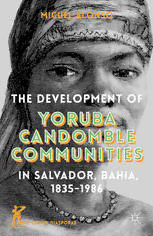
The Development of Yoruba Candomble Communities in Salvador, Bahia, 1835–1986 PDF
Preview The Development of Yoruba Candomble Communities in Salvador, Bahia, 1835–1986
THE DEVELOPMENT OF YORUBA CANDOMBLE COMMUNITIES IN SALVADOR, BAHIA, 1835–1986 AFRO-LATIN@ DIASPORAS Series Editors: Juan Flores, Natasha Gordon-Chipembere, and Miriam Jimenez Roman The Afro-Latin@ Diasporas book Series publishes scholarly and creative writing on the African diasporic experience in Latin America, the Caribbean, and the United States. The series includes books which address all aspects of Afro-Latin@ life and cultural expression throughout the hemisphere, with a strong focus on Afro-Latin@s in the United States. This series is the first of its kind to combine such a broad range of topics, including religion, race, transnational identity, history, literature, music and the arts, social and cultural theory, biography, class and economic relations, gender, sexuality, sociology, politics, and migration. Published: The Development of Yoruba Candomble Communities in Salvador, Bahia, 1835–1986 Miguel C. Alonso Life and Poems of a Cuban Slave: Juan Francisco Manzano 1797–1854 Edited by Edward J. Mullen The Development of Yoruba Candomble Communities in Salvador, Bahia, 1835–1986 Miguel C. Alonso THE DEVELOPMENT OF YORUBA CANDOMBLE COMMUNITIES IN SALVADOR, BAHIA, 1835–1986 Copyright © Miguel C. Alonso, 2014. Softcover reprint of the hardcover 1st edition 2014 All rights reserved. First published in 2014 by PALGRAVE MACMILLAN® in the United States— a division of St. Martin’s Press LLC, 175 Fifth Avenue, New York, NY 10010. Where this book is distributed in the UK, Europe and the rest of the world, this is by Palgrave Macmillan, a division of Macmillan Publishers Limited, registered in England, company number 785998, of Houndmills, Basingstoke, Hampshire RG21 6XS. Palgrave Macmillan is the global academic imprint of the above companies and has companies and representatives throughout the world. Palgrave® and Macmillan® are registered trademarks in the United States, the United Kingdom, Europe and other countries. ISBN: 978–1–137–48538–0 Library of Congress Cataloging-in-Publication Data Alonso, Miguel C. The development of Yorùbá Candomblé communities in Salvador, Bahia, 1835–1986 / Miguel C. Alonso. pages cm Includes bibliographical references. ISBN 978–1–137–48538–0 (hardback : alk. paper) 1. Candomblé (Religion)—Brazil—Salvador—History. 2. Yoruba (African people)—Brazil—Salvador—History. 3. Salvador (Brazil)—Religious life and customs. I. Title. BL2592.C35A47 2014 299.6(cid:2)73098142—dc23 2014026199 A catalogue record of the book is available from the British Library. Design by Newgen Knowledge Works (P) Ltd., Chennai, India. First edition: December 2014 10 9 8 7 6 5 4 3 2 1 ISBN 978-1-349-50365-0 ISBN 978-1-137-48643-1 (eBook) DOI 10.1057/9781137486431 Dedicated to the memory of Haydée Maria dos Santos Paim Mãe Dede Saudades. Vão Ficar Para Sempre This page intentionally left blank Contents List of Figures ix Acknowledgments xi Introduction How the Yoruba Became Nagô 1 Chapter 1 The African Nations of Salvador 15 Chapter 2 The Dispersal of the Yoruba People 33 Chapter 3 The Institutionalization of Yoruba Female Power in Nagô Candomble 49 Chapter 4 Self-Defense Strategies in Bahian Candomble in the Nineteenth and Twentieth Centuries 73 Chapter 5 The Reassertion of Male Participation in the Candomble Priesthood 103 Chapter 6 The Popularization of Candomble in the Mid- to Late Twentieth Century 131 Notes 149 Bibliography 175 Index 189 This page intentionally left blank Figures 1.1 Map of Brazil 16 2.1 Map of Yorubaland 34 3.1 Devotees descending staircase leading to Engenho Velho, 1938. Photo courtesy: Smithsonian Institution, National Anthropologial Archive, Ruth Landes Papers 57 4.1 E dison Carneiro. Photo courtesy: Smithsonian Institution, National Anthropological Archive, Ruth Landes Papers 86 4.2 L iberated African slaves returning to Lagos in the late nineteenth century. Photo courtesy: Smithsonian Institution, Anacostia Community Museum, Lorenzo Turner Papers 95 4.3 M artiniano Do Bomfim. Photo courtesy: Smithsonisan Institution, Anacostia Community Museum, Lorenzo Turner Papers 97 4.4 M ãe Aninha. Photo courtesy: Smithsonian Institution, Anacostia Community Museum, Lorenzo Turner Papers 101 5.1 Manoel, Ogan of Gantois standing in front of temple, 1938. Photo courtesy: Smithsonian Institution, National Anthropological Archive, Ruth Landes Papers 112 6.1 M ãe Menininha standing in front of women and children of Gantois. Photo courtesy: Smithsonian Institution, National Anthropological Archive, Ruth Landes Papers 137
